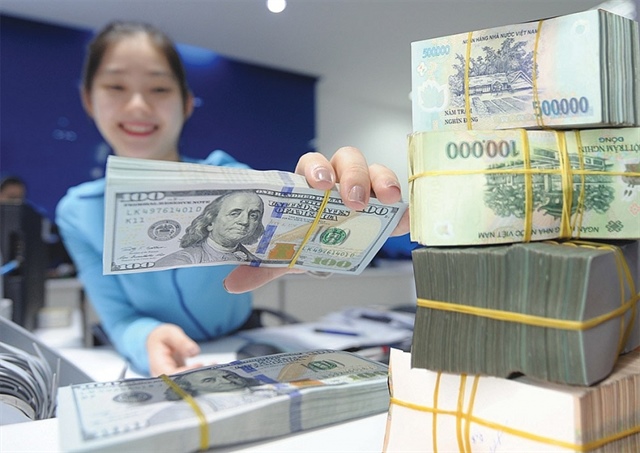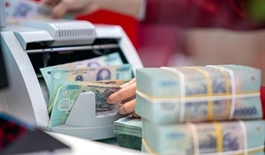Policy tools in play as exchange rate rises
Policy tools in play as exchange rate rises
As the VND hits record lows against the USD, Vietnam’s central bank is stepping up liquidity management and signalling readiness for stronger interventions to ease exchange rate volatility and safeguard macroeconomic stability.

The USD/VND exchange rate is under considerable pressure, photo Le Toan |
On July 4, the State Bank of Vietnam (SBV) further raised the central exchange rate to a high of VND25,091 per USD, following consecutive record-setting levels of VND25,070 on July 2 and 3. This marks the third peak within a week.
Commercial banks followed suit, raising their rates to unprecedented levels, with USD selling prices at many banks nearing the regulatory ceiling of VND26,370.
To counter mounting currency pressure, last week, the SBV issued approximately $900 million in 7-day T-bills at interest rates of 3.45-3.5 per cent. Simultaneously, the SBV injected a net $2.81 billion into the open market, primarily in 7- and 14-day terms, at a 4 per cent rate.
By week’s end, onshore forwards and T-bills in circulation reached around $3.61 billion and $900 million respectively, illustrating the SBV’s proactive liquidity management to stabilise the exchange rate amid persistent external pressures.
Do Bao Ngoc, deputy CEO of Vietnam Construction Securities, stated that the recent depreciation of several currencies reflects how governments are reacting to developments surrounding tariff policies. In Vietnam, the SBV has proactively injected liquidity into the market and maintained low interest rates.
“At times, the overnight interbank lending rate has dropped below 2 per cent, clearly demonstrating the central bank’s flexible monetary approach to swiftly address external risks, particularly those stemming from tariff policies of major trading partners,” he explained. “If exchange rate pressure persists and the VND depreciates more sharply in the coming period, the SBV will certainly intervene, including through the use of policy interest rates. However, raising rates would be a last resort, only considered if other measures prove ineffective.”
The SBV has already taken action by resuming the issuance of treasury bills to absorb excess liquidity from the system and reduce exchange-rate volatility. This tool has been used quite effectively over the past two years.
“It is likely to continue being deployed in the current environment. Treasury bill issuance not only helps sterilise liquidity but may also nudge up interbank rates slightly, thereby supporting the exchange rate and limiting the downward pressure on the VND,” added Ngoc.
Regarding the outlook for global monetary policy, expectations for a US Federal Reserve rate cut in July may be revised, as US economic data continues to show resilience, while renewed geopolitical tensions add to inflationary risks. All attention is now focused on the next moves by the US towards its negotiating partners.
Meanwhile, several countries involved in geopolitical tensions have already achieved certain objectives and are no longer exerting significant pressure on the global economy.
“Although the probability of a Fed rate cut in July is low, it will likely rise sharply in September and December. At that point, pressure on the VND exchange rate will certainly ease,” Ngoc added.
Finance expert Nguyen Tri Hieu stated that the USD/VND exchange rate in Vietnam is under considerable pressure as tariff-related uncertainties still loom over the market, despite expectations for a reduction to 20 per cent.
“Meanwhile, credit growth remains high, with the credit-to-GDP ratio reaching 134 per cent, posing risks to the economy. Additionally, domestic gold prices have remained elevated, nearing $4,800 per tael. The gap between domestic and international gold prices is still wide. All of these factors are contributing to the upward pressure on the exchange rate,” he added.
Dao Hong Duong, director of Stock and Industry Analysis at VPBank Securities, noted that according to recent sources, Vietnam’s foreign currency debt repayments in 2025 are expected to reach between $6.5-8 billion.
Compared to 2024 and the average of the past four years, this represents a significant increase in foreign debt obligations.
“In addition, the overnight interest rate differential between the USD and VND currently stands at around 2.6 percentage points. This has discouraged businesses from borrowing in foreign currencies, as the cost of such loans has become relatively higher than those in local currency,” Duong said.
Nguyen Duc Lenh, deputy director of the SBV’s Region 2 added that the nature of the exchange rate is that it is a price, and thus it must fluctuate with the market.
“At present, this fluctuation is under control and has not posed any harm to macroeconomic stability or the operations of import-export businesses. Stability here does not imply fixing the rate at a certain level,” Lenh said. “The exchange rate may increase by 2-3 per cent annually, but still within the central bank’s policy orientation.”
- 13:00 07/07/2025



























